Morris Rippel
(1930-2009)
Although he took his first art lesson at the age of 10, Morris Rippel did not become a professional artist until he was well into adult life. He studied architecture at the University of New Mexico. Following graduation, he spent several years in the architectural field and painted only as a hobby. However, after he sold the first two paintings that he submitted to a Santa Fe gallery, he decided that he could turn his hobby into a profession. He specialized in watercolors and the difficult medium of egg tempera. His early artistic influences were Edward Hopper and Andrew Wyeth, both of whom were also masters of those two techniques. He became a member of the National Academy of Western Art in 1975 and won the prestigious Prix de West prize presented by the National Cowboy and Western Heritage Museum in Oklahoma City in 1979. Previously he had won gold medals for his watercolors in that show in 1976 and 1977. In addition to the National Cowboy and Western Heritage Museum, his work is in the permanent collections of the Denver Art Museum, the Eiteljorg Museum, and the Gilcrease Museum.

Spirit Wings
Artist: Morris Rippel (1930-2009)
Description: Watercolor | Image Size: 16”h x 26”w; Framed Size: 25 ½”h x 35 ½”wpainting
This is another dramatic depiction of ancient cliff dwellings by Morris Rippel. The cliffs and the dwellings built into the canyon wall fill the entire canvas. Color changes are nuanced and subtle, reflecting the way the eye would perceive the scene were one to be standing at the same vantage point. Partial sunlight bathes the left side of the scene, while the remainder of the painting is shown in shadow. Only an artist with Rippel’s skill and familiarity with the light of the Southwest as well as his knowledge of and respect for the people who inhabited the area could realistically and effectively capture the essence of this place.
Were you able to locate the spirit wings?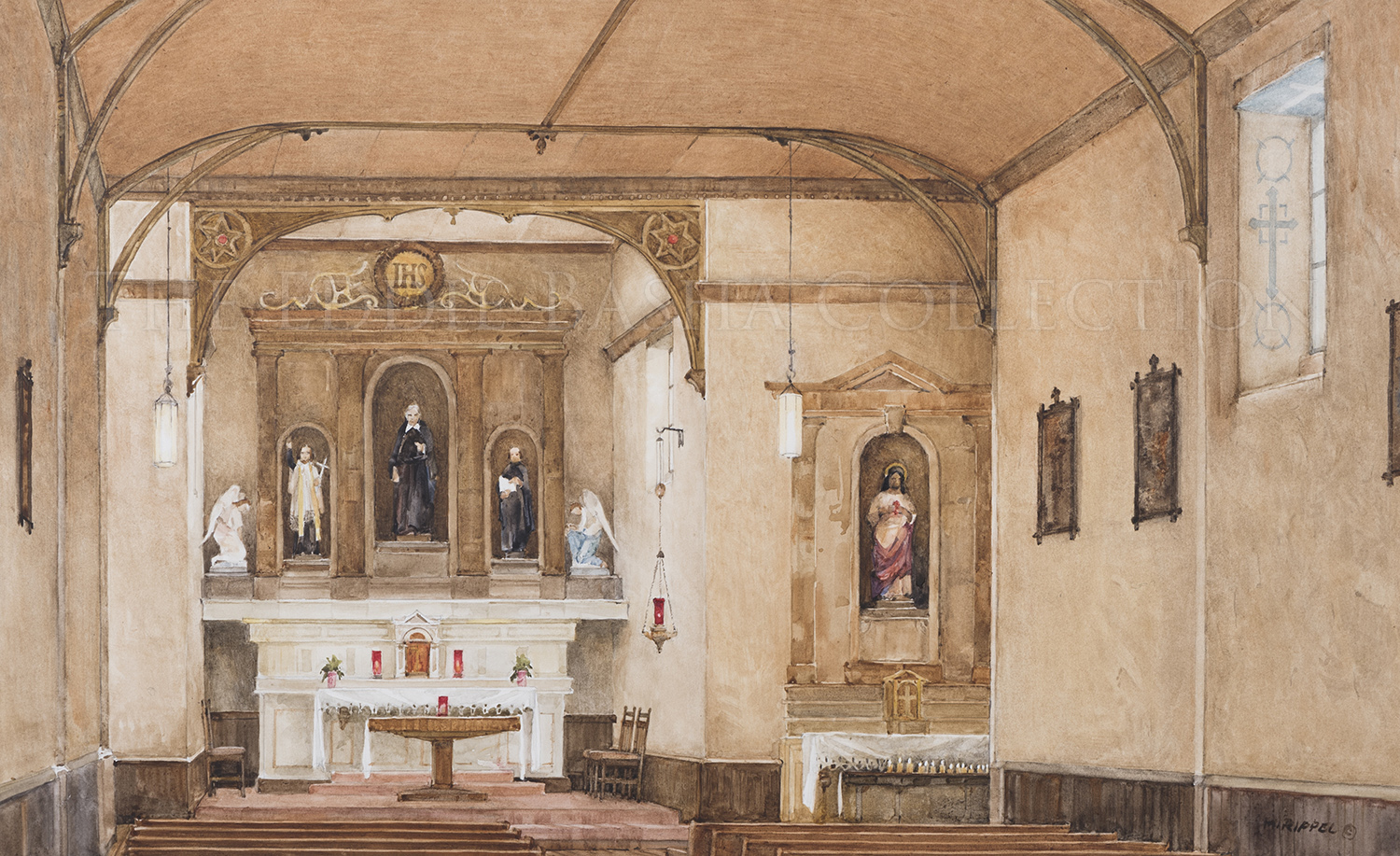
San Felipe de Neri
Artist: Morris Rippel (1930-2009)
Description: Watercolor (2001) | Image Size: 13 ½”h x 22”w; Framed Size: 22”h x 28”wpainting
San Felipe de Neri Church is a historic Catholic church located on the north side of Old Town Plaza in Albuquerque, New Mexico. Built in 1793, it is one of the oldest surviving buildings in the city and the only building in Old Town proven to date to the Spanish colonial period. The church is listed on the New Mexico State Register of Cultural Properties and the National Register of Historic Places and has remained in continuous use for over 200 years.
San Felipe de Neri replaced an older church, dating to the founding of Albuquerque in 1706, which collapsed in the winter of 1792–3. From its founding until 1817, the church was run by Franciscan missionaries. During the Victorian era, under the influence of Bishop Jean-Baptiste Lamy, the church was remodeled with Gothic Revival elements, including bell towers, a pitched roof and interior decorations to give it a more European appearance. This combination of elements from different periods and traditions makes the church notable architecturally as well as historically.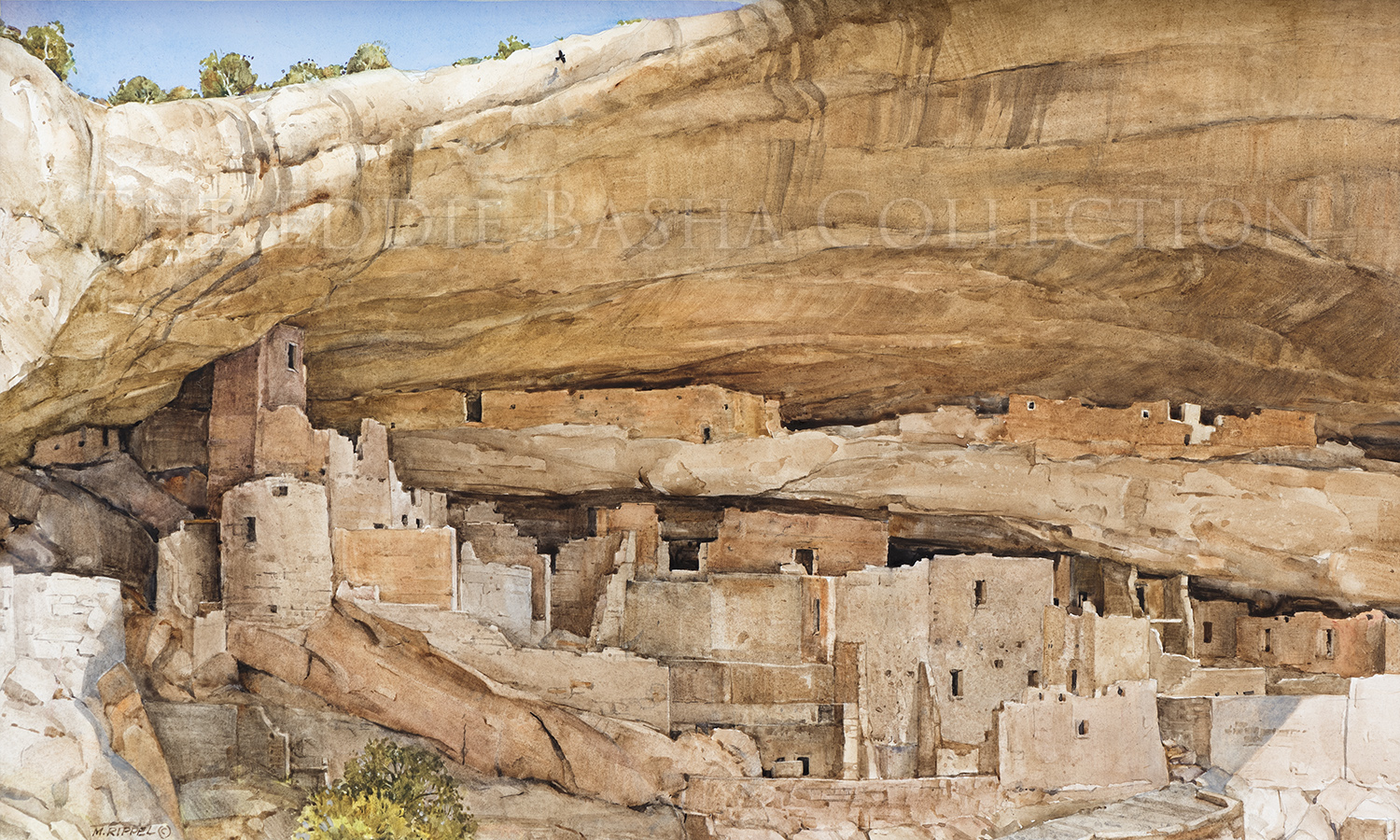
Edge of Silence
Artist: Morris Rippel (1930-2009)
Description: Watercolor | Image Size: 16”h x 26”w; Framed Size: 25 ¼”h x 35 ½”wpainting
Having spent many years painting in the American Southwest, particularly Northern New Mexico, Morris Rippel was adept at capturing its essence and focused on a wide range of subjects and locales. Among his favorite subjects were the cliff dwellings, now long abandoned, that had been home to whole societies of indigenous people. Rippel was able to perfectly capture the look and feel of these villages that were built into the deep recesses and caves of rocky canyons. In this watercolor, he expertly shows the scope of the dwellings by presenting them in full context relative to the cliffs. A master colorist, Rippel always painted such scenes with a sure sense of light and texture.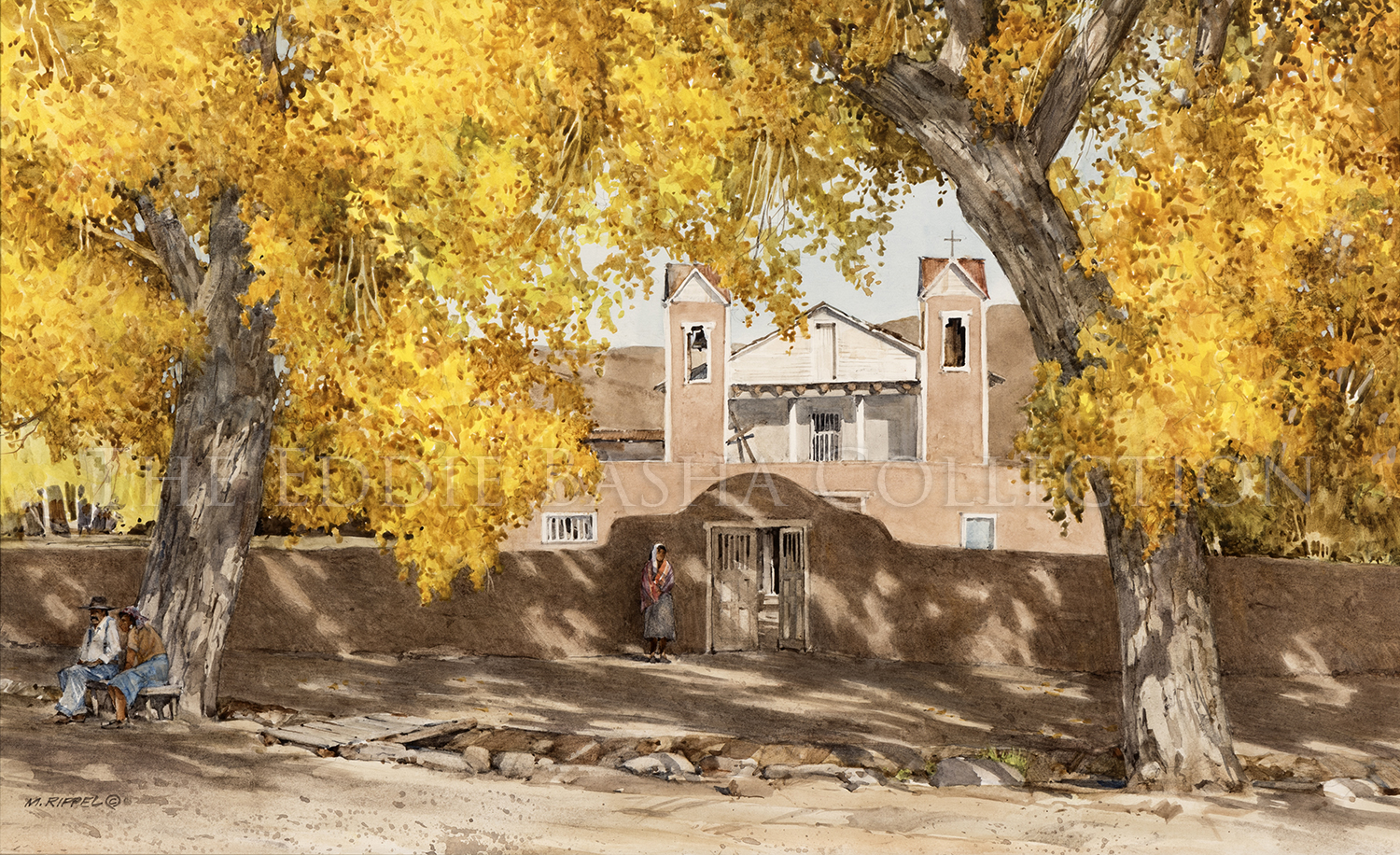
The Conversation
Artist: Morris Rippel (1930-2009)
Description: Watercolor (1999) | Image Size: 13 ½”h x 22”w; Framed Size: 17 ½”h x 26”wpainting
Morris Rippel’s masterful use of light, shadow, texture, and color are all on display in this watercolor of a Southwestern church which is neatly framed by two towering cottonwood trees shown in the brilliant golds and yellows of a New Mexico fall. The opening in the Cottonwood canopy draws the viewer’s eye toward the church in the background. The foreground is shaded obscuring some of the details such as the woman standing beside a doorway in the center of the canvas and a couple seated on the far left of the painting. Here and in many other watercolors, Rippel subtlety calls attention to the pair talking by titling the scene, “The Conversation”.
Rippel had a great eye for detail aided by the inclusion of a variety of nuances of a particular scene. Visually his paintings provide a true sense of place.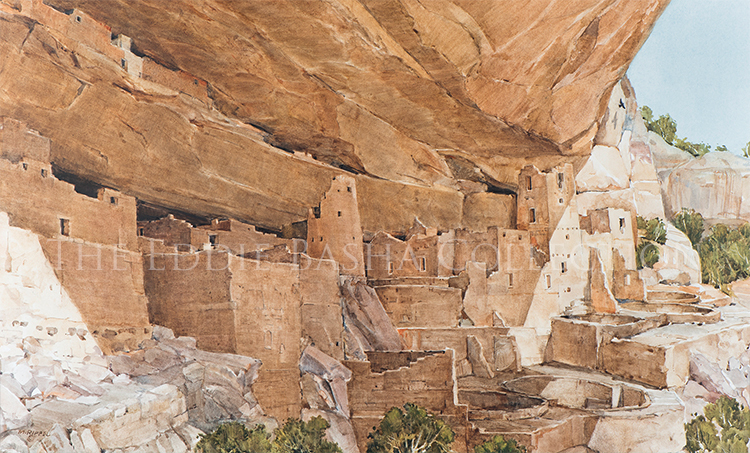
Spirit of the Speaker Chief
Artist: Morris Rippel (1930-2009)
Description: Drybrush Watercolor (2002) | Image Size: 13 ½” x 22”; Framed Size: 20”h x 28 ½”wpainting
This dramatic view of ancient cliff dwellings at Mesa Verde shows Morris Rippel at his finest. His use of light and shadow to enhance the dramatic appeal, his attention to detail, his highly accurate drawing of every aspect of the scene, and his effective blending of colors, succeeds in capturing the essence of this ancient place.
The National Park Service website indicates that the cliff dwellings of Mesa Verde are some of the most notable and best preserved in the North American Continent. Sometime during the late 1190’s, after primarily living on the mesa top for 600 years, many Ancestral Pueblo people began living in pueblos they built beneath the overhanging cliffs. The structures ranged in size from one-room storage units to villages of more than 150 rooms. While still farming the mesa tops, they continued to reside in the alcoves, repairing, remodeling, and constructing new rooms for nearly a century. By the late 1270’s, the population began migrating south into present-day New Mexico and Arizona. By 1300, the Ancestral Puebloan occupation of Mesa Verde ended.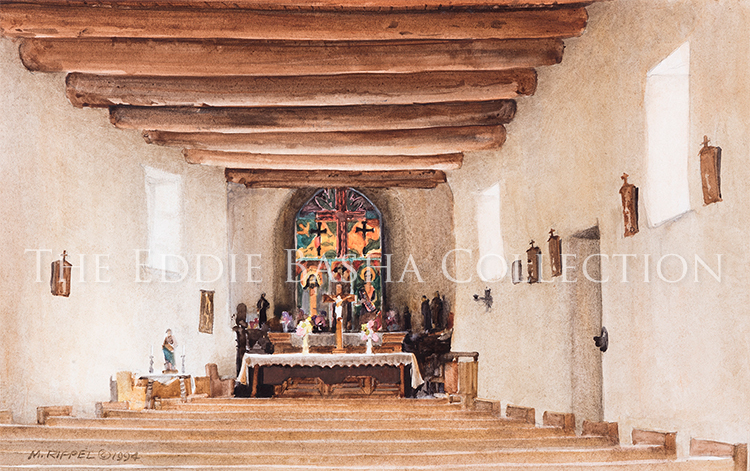
Light of Faith
Artist: Morris Rippel (1930-2009)
Description: Watercolor | Image Size: 7 ½”h x 12”w; Framed Size: 16 ¼”h x 20 ½”wpainting
With his architectural background and passion for old adobe structures, Morris Rippel characteristically captured the ambiance of this New Mexico chapel in a small format.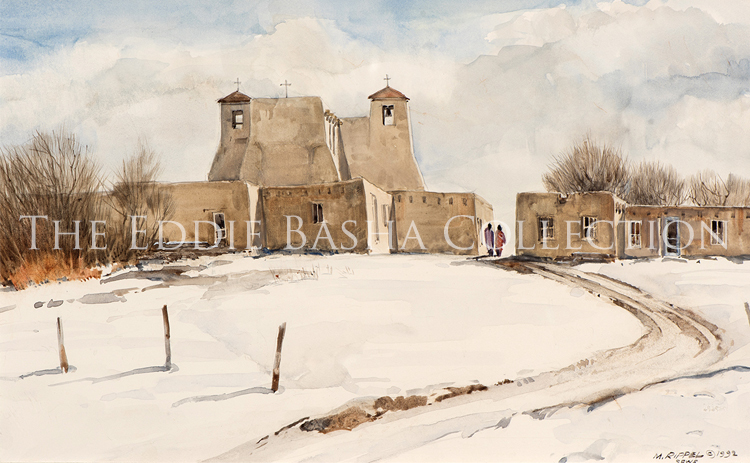
Isleta
Artist: Morris Rippel (1930-2009)
Description: Watercolor on Board (1992) | Image Size: 10”h x 16”w; Framed Size: 16 ¾”h x 22 ¾”wpainting
A curving road winds through the foreground of this winter scene leading the viewer’s eye from the bottom of the canvas to the painting’s subject, the church at Isleta, New Mexico. The ground is covered with snow and Morris Rippel realistically tinged the whiteness of the snow with hints of browns. Two figures are seen on the road and are moving toward the church. A splash of reddish orange is seen in the far left denoting a typical Southwestern plant. Clouds fill the sky and along with the snowy ground, frame the buildings in the scene. The mood conveyed is one of quiet reflection.
Although he took his first art lesson at the age of 10, Morris Rippel did not become a professional artist until he was well into adult life. He studied architecture at the University of New Mexico. Following graduation, he spent several years in the architectural field and painted only as a hobby. However, after he sold the first two paintings that he submitted to a Santa Fe gallery, he decided that he could turn his hobby into a profession. He specialized in watercolors and the difficult medium of egg tempera. His early artistic influences were Edward Hopper and Andrew Wyeth, both of whom were also masters of those two techniques. He became a member of the National Academy of Western Art in 1975 and won the prestigious Prix de West prize presented by the National Cowboy & Western Heritage Museum in Oklahoma City in 1979. Previously he had won gold medals for his watercolors in that show in 1976 and 1977. In addition to the National Cowboy and Western Heritage Museum, his work is in the permanent collections of the Denver Art Museum, the Eiteljorg Museum of American Indians and Western Art, and the Gilcrease Museum.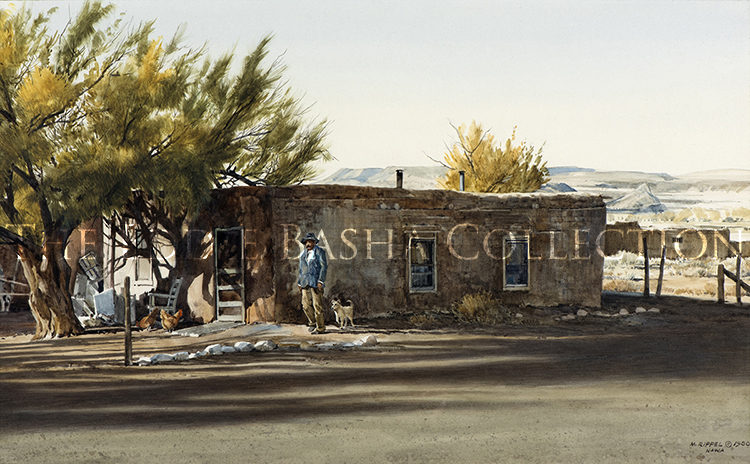
El Llanito
Artist: Morris Rippel (1930-2009)
Description: Watecolor/Tempura (1980) | Image Size: 13”h x 22”w; Framed Size: 21 ½”h x 29 ½”wpainting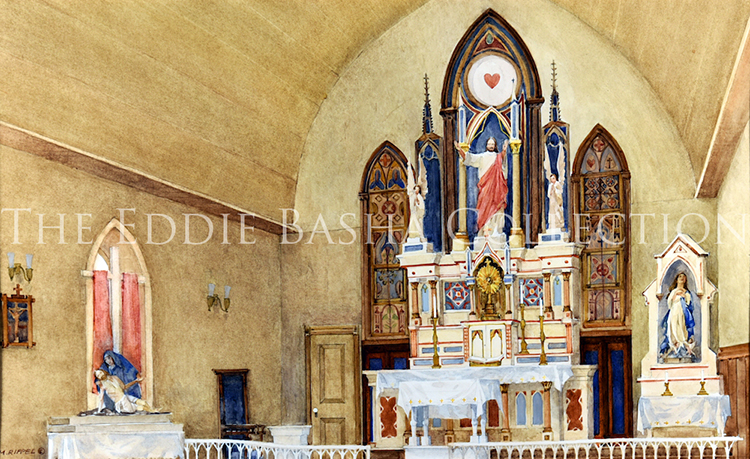
Sacred Heart of the Valley
Artist: Morris Rippel (1930-2009)
painting
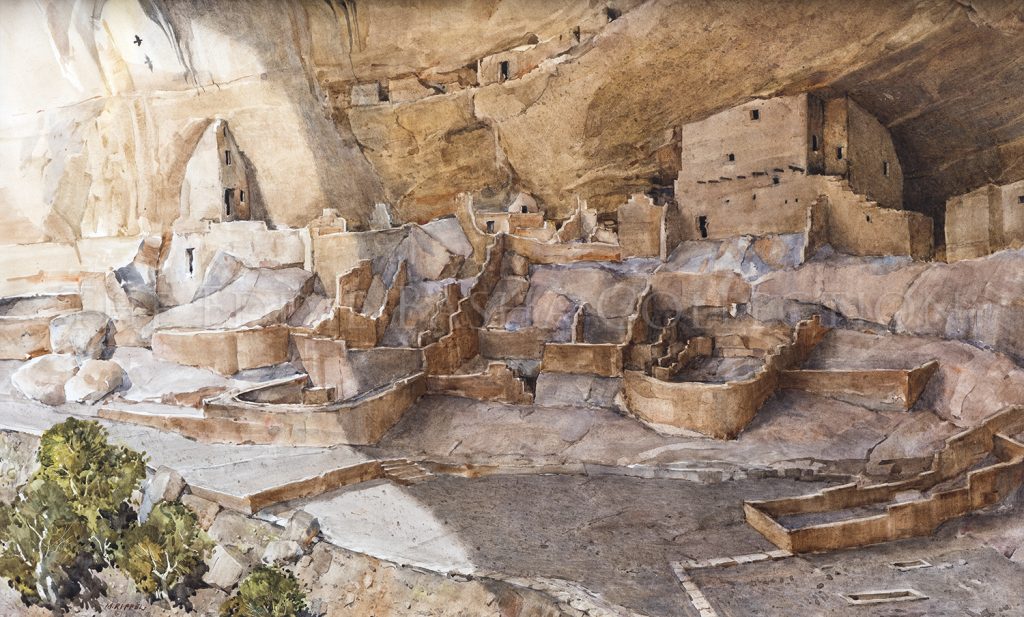 Watercolor | Image Size: 16”h x 26”w; Framed Size: 25 ½”h x 35 ½”w
Watercolor | Image Size: 16”h x 26”w; Framed Size: 25 ½”h x 35 ½”wThis is another dramatic depiction of ancient cliff dwellings by Morris Rippel. The cliffs and the dwellings built into the canyon wall fill the entire canvas. Color changes are nuanced and subtle, reflecting the way the eye would perceive the scene were one to be standing at the same vantage point. Partial sunlight bathes the left side of the scene, while the remainder of the painting is shown in shadow. Only an artist with Rippel’s skill and familiarity with the light of the Southwest as well as his knowledge of and respect for the people who inhabited the area could realistically and effectively capture the essence of this place.
Were you able to locate the spirit wings?
Spirit Wings
Artist: Morris Rippel (1930-2009)
This is another dramatic depiction of ancient cliff dwellings by Morris Rippel. The cliffs and the dwellings built into the canyon wall fill the entire canvas. Color changes are nuanced and subtle, reflecting the way the eye would perceive the scene were one to be standing at the same vantage point. Partial sunlight bathes the left side of the scene, while the remainder of the painting is shown in shadow. Only an artist with Rippel’s skill and familiarity with the light of the Southwest as well as his knowledge of and respect for the people who inhabited the area could realistically and effectively capture the essence of this place.
Were you able to locate the spirit wings?
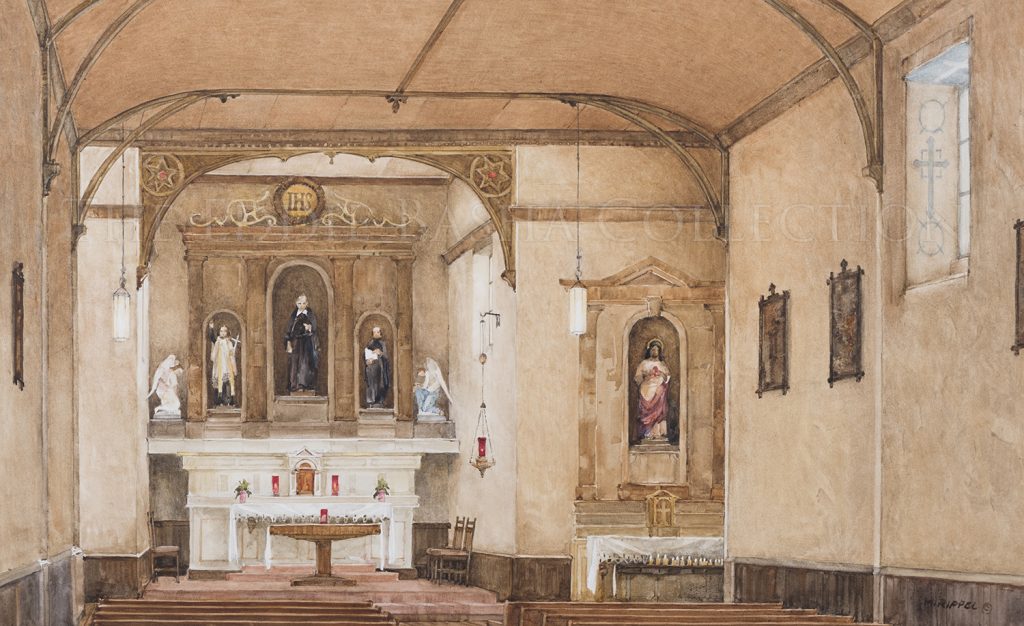 Watercolor (2001) | Image Size: 13 ½”h x 22”w; Framed Size: 22”h x 28”w
Watercolor (2001) | Image Size: 13 ½”h x 22”w; Framed Size: 22”h x 28”wSan Felipe de Neri Church is a historic Catholic church located on the north side of Old Town Plaza in Albuquerque, New Mexico. Built in 1793, it is one of the oldest surviving buildings in the city and the only building in Old Town proven to date to the Spanish colonial period. The church is listed on the New Mexico State Register of Cultural Properties and the National Register of Historic Places and has remained in continuous use for over 200 years.
San Felipe de Neri replaced an older church, dating to the founding of Albuquerque in 1706, which collapsed in the winter of 1792–3. From its founding until 1817, the church was run by Franciscan missionaries. During the Victorian era, under the influence of Bishop Jean-Baptiste Lamy, the church was remodeled with Gothic Revival elements, including bell towers, a pitched roof and interior decorations to give it a more European appearance. This combination of elements from different periods and traditions makes the church notable architecturally as well as historically.
San Felipe de Neri
Artist: Morris Rippel (1930-2009)
San Felipe de Neri Church is a historic Catholic church located on the north side of Old Town Plaza in Albuquerque, New Mexico. Built in 1793, it is one of the oldest surviving buildings in the city and the only building in Old Town proven to date to the Spanish colonial period. The church is listed on the New Mexico State Register of Cultural Properties and the National Register of Historic Places and has remained in continuous use for over 200 years.
San Felipe de Neri replaced an older church, dating to the founding of Albuquerque in 1706, which collapsed in the winter of 1792–3. From its founding until 1817, the church was run by Franciscan missionaries. During the Victorian era, under the influence of Bishop Jean-Baptiste Lamy, the church was remodeled with Gothic Revival elements, including bell towers, a pitched roof and interior decorations to give it a more European appearance. This combination of elements from different periods and traditions makes the church notable architecturally as well as historically.
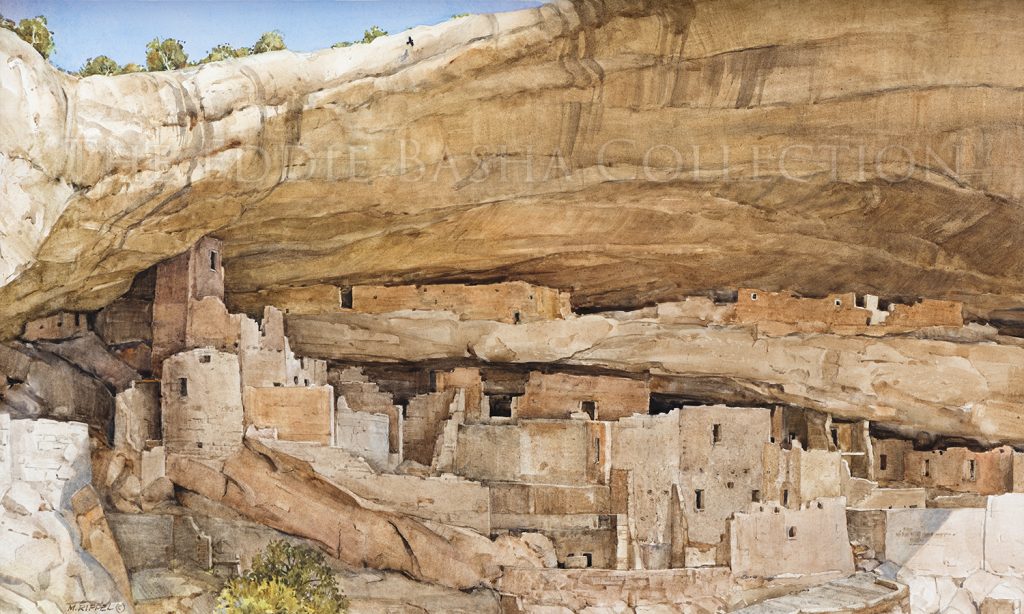 Watercolor | Image Size: 16”h x 26”w; Framed Size: 25 ¼”h x 35 ½”w
Watercolor | Image Size: 16”h x 26”w; Framed Size: 25 ¼”h x 35 ½”wHaving spent many years painting in the American Southwest, particularly Northern New Mexico, Morris Rippel was adept at capturing its essence and focused on a wide range of subjects and locales. Among his favorite subjects were the cliff dwellings, now long abandoned, that had been home to whole societies of indigenous people. Rippel was able to perfectly capture the look and feel of these villages that were built into the deep recesses and caves of rocky canyons. In this watercolor, he expertly shows the scope of the dwellings by presenting them in full context relative to the cliffs. A master colorist, Rippel always painted such scenes with a sure sense of light and texture.
Edge of Silence
Artist: Morris Rippel (1930-2009)
Having spent many years painting in the American Southwest, particularly Northern New Mexico, Morris Rippel was adept at capturing its essence and focused on a wide range of subjects and locales. Among his favorite subjects were the cliff dwellings, now long abandoned, that had been home to whole societies of indigenous people. Rippel was able to perfectly capture the look and feel of these villages that were built into the deep recesses and caves of rocky canyons. In this watercolor, he expertly shows the scope of the dwellings by presenting them in full context relative to the cliffs. A master colorist, Rippel always painted such scenes with a sure sense of light and texture.
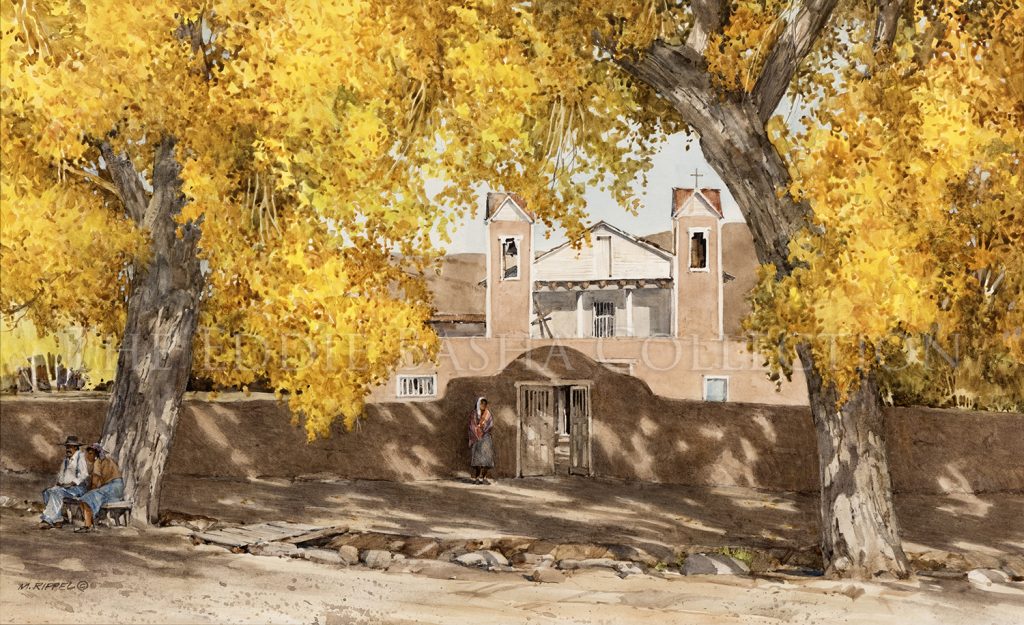 Watercolor (1999) | Image Size: 13 ½”h x 22”w; Framed Size: 17 ½”h x 26”w
Watercolor (1999) | Image Size: 13 ½”h x 22”w; Framed Size: 17 ½”h x 26”wMorris Rippel’s masterful use of light, shadow, texture, and color are all on display in this watercolor of a Southwestern church which is neatly framed by two towering cottonwood trees shown in the brilliant golds and yellows of a New Mexico fall. The opening in the Cottonwood canopy draws the viewer’s eye toward the church in the background. The foreground is shaded obscuring some of the details such as the woman standing beside a doorway in the center of the canvas and a couple seated on the far left of the painting. Here and in many other watercolors, Rippel subtlety calls attention to the pair talking by titling the scene, “The Conversation”.
Rippel had a great eye for detail aided by the inclusion of a variety of nuances of a particular scene. Visually his paintings provide a true sense of place.
The Conversation
Artist: Morris Rippel (1930-2009)
Morris Rippel’s masterful use of light, shadow, texture, and color are all on display in this watercolor of a Southwestern church which is neatly framed by two towering cottonwood trees shown in the brilliant golds and yellows of a New Mexico fall. The opening in the Cottonwood canopy draws the viewer’s eye toward the church in the background. The foreground is shaded obscuring some of the details such as the woman standing beside a doorway in the center of the canvas and a couple seated on the far left of the painting. Here and in many other watercolors, Rippel subtlety calls attention to the pair talking by titling the scene, “The Conversation”.
Rippel had a great eye for detail aided by the inclusion of a variety of nuances of a particular scene. Visually his paintings provide a true sense of place.
 Drybrush Watercolor (2002) | Image Size: 13 ½” x 22”; Framed Size: 20”h x 28 ½”w
Drybrush Watercolor (2002) | Image Size: 13 ½” x 22”; Framed Size: 20”h x 28 ½”wThis dramatic view of ancient cliff dwellings at Mesa Verde shows Morris Rippel at his finest. His use of light and shadow to enhance the dramatic appeal, his attention to detail, his highly accurate drawing of every aspect of the scene, and his effective blending of colors, succeeds in capturing the essence of this ancient place.
The National Park Service website indicates that the cliff dwellings of Mesa Verde are some of the most notable and best preserved in the North American Continent. Sometime during the late 1190’s, after primarily living on the mesa top for 600 years, many Ancestral Pueblo people began living in pueblos they built beneath the overhanging cliffs. The structures ranged in size from one-room storage units to villages of more than 150 rooms. While still farming the mesa tops, they continued to reside in the alcoves, repairing, remodeling, and constructing new rooms for nearly a century. By the late 1270’s, the population began migrating south into present-day New Mexico and Arizona. By 1300, the Ancestral Puebloan occupation of Mesa Verde ended.
Spirit of the Speaker Chief
Artist: Morris Rippel (1930-2009)
This dramatic view of ancient cliff dwellings at Mesa Verde shows Morris Rippel at his finest. His use of light and shadow to enhance the dramatic appeal, his attention to detail, his highly accurate drawing of every aspect of the scene, and his effective blending of colors, succeeds in capturing the essence of this ancient place.
The National Park Service website indicates that the cliff dwellings of Mesa Verde are some of the most notable and best preserved in the North American Continent. Sometime during the late 1190’s, after primarily living on the mesa top for 600 years, many Ancestral Pueblo people began living in pueblos they built beneath the overhanging cliffs. The structures ranged in size from one-room storage units to villages of more than 150 rooms. While still farming the mesa tops, they continued to reside in the alcoves, repairing, remodeling, and constructing new rooms for nearly a century. By the late 1270’s, the population began migrating south into present-day New Mexico and Arizona. By 1300, the Ancestral Puebloan occupation of Mesa Verde ended.
 Watercolor | Image Size: 7 ½”h x 12”w; Framed Size: 16 ¼”h x 20 ½”w
Watercolor | Image Size: 7 ½”h x 12”w; Framed Size: 16 ¼”h x 20 ½”wWith his architectural background and passion for old adobe structures, Morris Rippel characteristically captured the ambiance of this New Mexico chapel in a small format.
Light of Faith
Artist: Morris Rippel (1930-2009)
With his architectural background and passion for old adobe structures, Morris Rippel characteristically captured the ambiance of this New Mexico chapel in a small format.
 Watercolor on Board (1992) | Image Size: 10”h x 16”w; Framed Size: 16 ¾”h x 22 ¾”w
Watercolor on Board (1992) | Image Size: 10”h x 16”w; Framed Size: 16 ¾”h x 22 ¾”wA curving road winds through the foreground of this winter scene leading the viewer’s eye from the bottom of the canvas to the painting’s subject, the church at Isleta, New Mexico. The ground is covered with snow and Morris Rippel realistically tinged the whiteness of the snow with hints of browns. Two figures are seen on the road and are moving toward the church. A splash of reddish orange is seen in the far left denoting a typical Southwestern plant. Clouds fill the sky and along with the snowy ground, frame the buildings in the scene. The mood conveyed is one of quiet reflection.
Although he took his first art lesson at the age of 10, Morris Rippel did not become a professional artist until he was well into adult life. He studied architecture at the University of New Mexico. Following graduation, he spent several years in the architectural field and painted only as a hobby. However, after he sold the first two paintings that he submitted to a Santa Fe gallery, he decided that he could turn his hobby into a profession. He specialized in watercolors and the difficult medium of egg tempera. His early artistic influences were Edward Hopper and Andrew Wyeth, both of whom were also masters of those two techniques. He became a member of the National Academy of Western Art in 1975 and won the prestigious Prix de West prize presented by the National Cowboy & Western Heritage Museum in Oklahoma City in 1979. Previously he had won gold medals for his watercolors in that show in 1976 and 1977. In addition to the National Cowboy and Western Heritage Museum, his work is in the permanent collections of the Denver Art Museum, the Eiteljorg Museum of American Indians and Western Art, and the Gilcrease Museum.
Isleta
Artist: Morris Rippel (1930-2009)
A curving road winds through the foreground of this winter scene leading the viewer’s eye from the bottom of the canvas to the painting’s subject, the church at Isleta, New Mexico. The ground is covered with snow and Morris Rippel realistically tinged the whiteness of the snow with hints of browns. Two figures are seen on the road and are moving toward the church. A splash of reddish orange is seen in the far left denoting a typical Southwestern plant. Clouds fill the sky and along with the snowy ground, frame the buildings in the scene. The mood conveyed is one of quiet reflection.
Although he took his first art lesson at the age of 10, Morris Rippel did not become a professional artist until he was well into adult life. He studied architecture at the University of New Mexico. Following graduation, he spent several years in the architectural field and painted only as a hobby. However, after he sold the first two paintings that he submitted to a Santa Fe gallery, he decided that he could turn his hobby into a profession. He specialized in watercolors and the difficult medium of egg tempera. His early artistic influences were Edward Hopper and Andrew Wyeth, both of whom were also masters of those two techniques. He became a member of the National Academy of Western Art in 1975 and won the prestigious Prix de West prize presented by the National Cowboy & Western Heritage Museum in Oklahoma City in 1979. Previously he had won gold medals for his watercolors in that show in 1976 and 1977. In addition to the National Cowboy and Western Heritage Museum, his work is in the permanent collections of the Denver Art Museum, the Eiteljorg Museum of American Indians and Western Art, and the Gilcrease Museum.